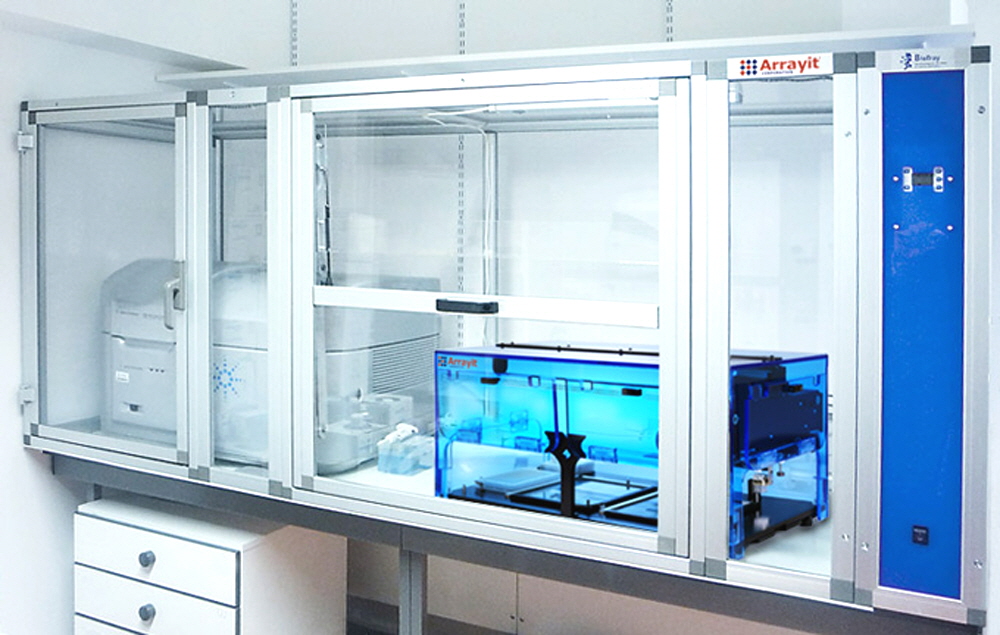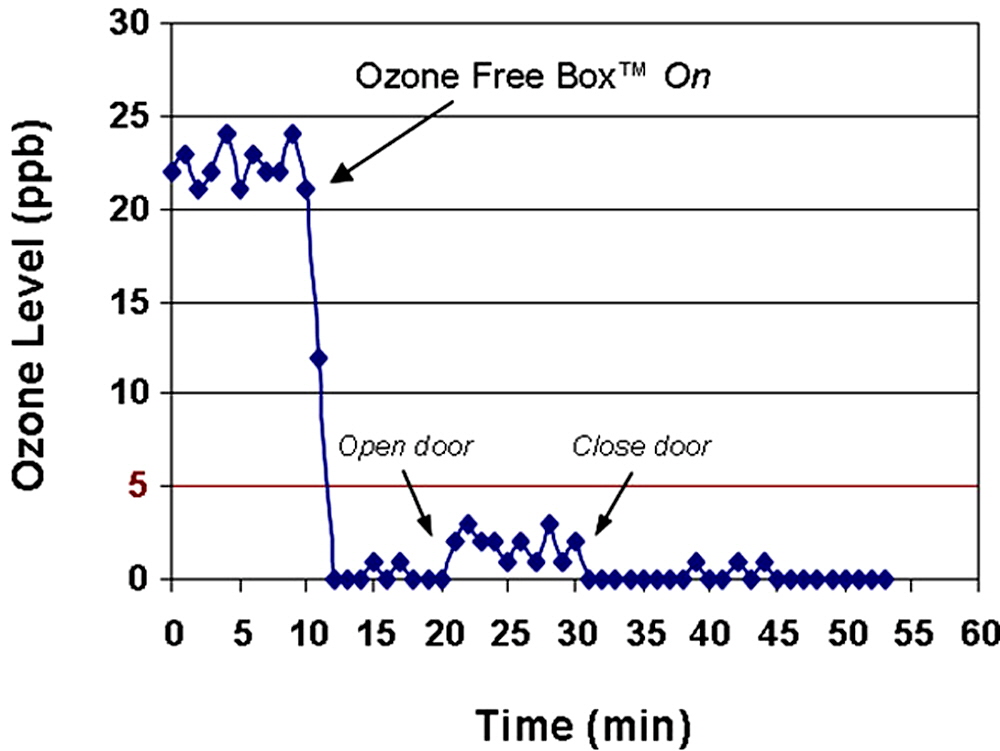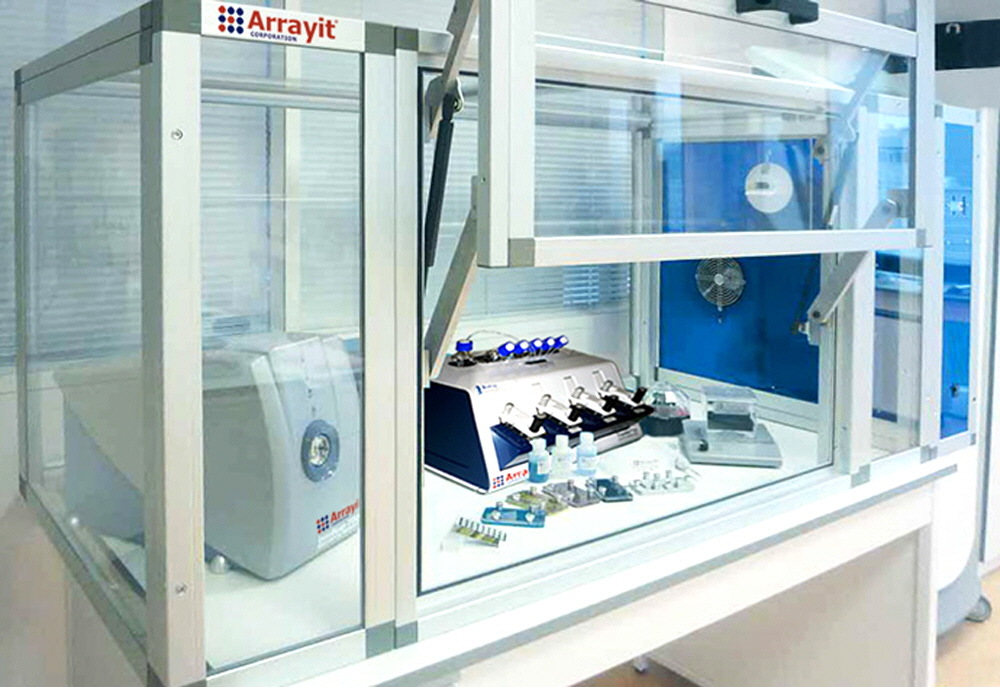Ozone Free Boxes
Data Sheet
![]() Shop this product in our online store
Shop this product in our online store
Arrayit | Microarray ozone-free boxes scanners fluorescent reagents aluminum custom sizes environmental enclosures life sciences research
Instruments - Microarray Processing - Ozone Free Boxes and Environmental Enclosures

Arrayit Ozone Free Boxes create optimal working environments in microarray laboratories using fluorescent dyes that degrade in ozone levels above 5 parts per billion (5 ppb). Ozone Free Boxes are used to enclose microarrayers, scanners and other equipment used to manufacture, process and read microarrays. Ambient air contains ozone levels from 10-150 ppb ppb depending on the presence of laser printers, computers and other equipment that generates ozone. Arrayit Ozone Free Boxes maintain low ozone levels using an ozone-free air curtain that is created across the front of the enclosure. Ozone Free Box 200 (Cat. OFB200) is shown here enclosing an Arrayit SpotBot® Extreme Microarrayer and an Agilent Microarray Scanner.
Mechanism of Ozone Depletion
Ozone Free Boxes use an air circulation loop to move the air inside the modular enclosures through highly efficient catalytic converters that convert ozone to oxygen. Dust and other small particles are removed using a HEPA filter located at the entry port of the centrifuge fan. The incorporation of the most powerful catalytic monolith technology available guarantees an ozone level lower than 1 ppb with the door closed and 5 ppb with the door open. Under normal atmospheric and temperature conditions, the catalyst filter should last 12-24 months. Ozone is converted to oygen using a 1.5 m/sec airflow to minimize turbulence inside the workspace.
Specifications
Dimensions and Work Area |
Ozone Free Boxes are available in several convenient work area configurations to meet the needs of all microarray applications. The depth is 80 cm for all models, the height is 80 cm or 100 cm, and length is 100 cm, 150 cm or 200 cm. Please add 21 cm to the actual length of each system for the Catalyst Filter Unit (shown in blue in Figs 4 and 5). See Ordering Information for enclosure dimensions. |
|
Box and Catalytic Converting Unit |
Anodized Aluminum Profiles with Transparent and Blue PMMA |
|
Doors |
PMMA plate with handles either vertical or horizontal according to the user needs |
|
Catalytic Monolith |
Dimensions |
125 x 125mm |
Thickness |
15mm |
|
Type |
Aluminum filter using MnO2 |
|
Air Flow |
1.5 m/s |
|
High Precision Sensor |
Mounted on support inside the enclosure connection to display via RJ45 connection |
|
Accuracy |
+- 0.1 parts per billion |
|
Calibrated Range |
0.000 – 0.150 ppm |
|
Response Time |
Less than 70 seconds |
|
Operating Temperature |
-5 to 50 degrees Celsius |
|
Power Supply |
12 VDC, 800 mA |
|
Fan |
1650 tr/mn – 150 W Adjustable speed, dust and particle filter |
|
Digital Display |
Realtime monitoring of ozone levels with a programmable alarm |
|
Electrical Requirements |
Power 105 W, Voltage 220V |
|
Switch |
ON/OFF located in the front of the unit |
|
Custom Configurations |
Enclosures are provided as sets of sealed anodized aluminum profiles with PMMA panels that are fastened together to form a workspace adaptable to the desired dimensions for any laboratory environment. The entire front region of the enclosures act as either vertical or horizontal doors which open and close very easily. Each enclosure we deliver is custom built to accommodate any size equipment. Please advise us of your requirements and we will prepare a quotation by email arrayit@arrayit.com. |
|

Figure 1. Arrayit Ozone Free Boxes mediate rapid ozone depletion, from an ambient concentration of 23 ppb to less than 1 ppb in 3 minutes. Ozone Free Boxes also maintain <5 ppb ozone with the front door open to allow researchers to perform important microarray tasks such as microarray printing, processing and scanning.

Figure 2. Comparison of identical microarrays exposed to different levels of ozone prior to scanning. Improved signal to noise ratios are easily observed. Cy5 is a registered trademark of GE Healthcare.

Figure 3. Arrayit Ozone Free Box 100 (Cat. OFB100) enclosing an Arrayit InnoScan® 710 High-Speed Two-Color Fluorescence Microarray Scanner, a TrayMix™ S2 Hybridization Station and a Microarray High-Speed Centrifuge.

Figure 4. Ozone Free Box Accessories are shown including the Ozone Sensor Head (A), Front Display Panel (B), and Replaceable Filter (C).

Figure 5. Arrayit Ozone Free Box 150 (Cat. OFB150) enclosing an Arrayit InnoScan® 710 High-Speed Two-Color Fluorescence Microarray Scanner, a TrayMix™ S4 Hybridization Station, a Microarray High-Speed Centrifuge, Hybridization Cassettes, and Fluorescent Probe Purification Kit buffers.

Figure 6. Arrayit Ozone Free Box 200 (Cat. OFB200) enclosing an Arrayit InnoScan® 710 High-Speed Two-Color Fluorescence Microarray Scanner, TrayMix™ S4 Hybridization Station, Microarray High-Speed Centrifuge, Hybridization Cassettes, and Fluorescent Probe Purification Kit buffers. The front door design permits easy access while maintaining <5 ppb ozone using an proprietary air curtain.
Scientific Publications
Ozone effects on fluorescent dyes commonly used for microarray experimentation are reported by the following publications:
Effects of Atmospheric Ozone on Microarray Data Quality.
http://www.genomics.princeton.edu/dunham/ozone.html
QA/QC: challenges and pitfalls facing the microarray community and regulatory agencies
Protocols for the assurance of microarray data quality and process control.

